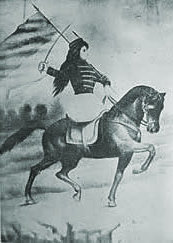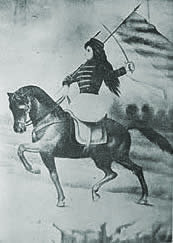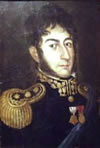
|
Women and Independence in Latin America An exploration of women's involvement in the Latin American Wars of Independence |

|

|
Women and Independence in Latin America An exploration of women's involvement in the Latin American Wars of Independence |

|
Click on one of the images below to see the full-size image
 José de San Martín |
 Jerónima San Martín |
 José de San Martín |
 José de San Martín |
 Medals |
 José de San Martín |
 San Martín's flag |
 José de San Martín |
 José de San Martin |
Gender:Male
Ethnic origen: White
Events:
| 1778 | - | Corrientes | - | Not applicable | - | He was born in 1777 or on 25 February 1778, Yapeyú, Corrientes, Argentina. |
| 1808 | - | Cadiz | - | Patriot | - | He met a group of Americans in Cadiz who sought independence. |
| 1808 | - | Portugal | - | Patriot | - | He served in the Portuguese campaign against France, fighting in the battles of Arjonilla and Bailén. |
| 1812 | - | Buenos Aires | - | Patriot | - | He married Remedios de Escalada on 12 November 1812. |
| 1812 | - | Buenos Aires | - | Patriot | - | He returned to Buenos Aires after serving in the Spanish army. |
| 1817 | - | Santiago de Chile | - | Patriot | - | He was offered the post of Director Supremo for his efforts in the liberation of Chile. |
| 1818 | - | Santiago de Chile | - | Patriot | - | He defeated the royalists at Maipú (near Santiago) and consolidated the liberation of Chile. |
| 1821 | - | Lima | - | Patriot | - | He occupied Lima on 12 July 1821 and proclaimed independence on 28th July. |
| 1821 | - | Lima | - | Patriot | - | He established the Biblioteca Nacional del Perú. |
| 1822 | - | Guayaquil | - | Patriot | - | He met Bolívar in Guayaquil in July 1822. |
| 1822 | - | Buenos Aires | - | Patriot | - | He retired into civilian life here after 1822. |
| 1825 | - | Brussels | - | Unknown | - | He wrote a moral guide for his daughter, Mercedes Tomasina. |
| 1830 | - | Paris | - | Unknown | - | Lived here from 1830 |
| 1850 | - | Boulogne-Sur-Mer | - | Unknown | - | He died on 17 August 1850 in Boulogne-Sur-Mer. |
Connections:
Chilean exiles (Mendoza)Texts:
1821 - Proclama a las Limeñas
1822 - Discurso
Biography:
He was born in Yapeyú, Corrientes, 25 February 1778. His family moved to Spain when he was still a child, where he began a military career. He served in Portugal in the campaign against France where he distinguished himself in the battles of Arjonilla and Bailén. He met a group of Americans in Cadiz who sought Independence and at the end of 1811 he resigned his military commission and left for Buenos Aires. There he organised the regiment Granaderos a Caballo who fought royalists in 1813 in San Lorenzo. San Martín was nearly killed in this battle. He was named Jefe of the Ejército del Norte and planned to liberate Chile and use the Pacific Ocean to reach Peru, the base of royalist power. He was made governor of Cuyo, and organised the Ejército de los Andes with which he crossed the mountains and won the battle at Chacabuco in 1817. He occupied Santiago where he rejected the post of Director Supremo de Chile in the interests of pursuing American liberty. In 1818 he defeated the royalists at Maipú and consolidated the liberation of Chile. The Buenos Aires government asked him to take part in the civil wars in Argentina, but he disobeyed and sailed for the Peruvian coast in 1820. After almost a year of waiting, he occupied Lima without a battle and on 28 July proclaimed the independence of Peru with him as Protector. He abolished personal tribute of the Indians, founded the Biblioteca Nacional and the Escuela Normal. His infamous meeting with Bolívar took place in Guayaquil in July 1822. He returned to Lima where he resigned as Protector when independence was secure. He retired to civilian life, returning to Buenos Aires and then went into voluntary exile in Europe. He returned in 1829, but did not want to disembark and become embroiled in the civil wars that were disintegrating his country. He returned to Europe and settled in Boulogne-Sur-Mer (France). His main preoccupation in his retirement from public life were the French and English interventions in Rio de la Plata. Old and ill, he was intensely involved in these struggles. He died on 17 August 1850 in Boulogne. (Enciclopedia Billiken)
He founded the Biblioteca Nacional del Perú in 1821 and donated his books as “one of the most effective methods of putting intellectual values into circulation”.
On 31 December 1821 he signed a declaration stating that theatre was a moral and political establishment of the highest value. (Seibel, 24)
In 1825 he wrote a moral guide for his daughter, Mercedes Tomasina, in which he advises her to love truth and hate lies, to be charitable towards the poor, respect other people's property, keep secrets, be kind to servants, the poor and the elderly. (Knaster, 241.)
Mary Graham met him in 1822. "San Martin has vulgarly been said to drink: I believe this is not true; but he is an opium eater, and his starts of passion are so frequent and violent, that no man feels his head safe…" (Mavor, 95) Although politically opposed to him through her friendship with Lord Cochrane, she could not help admiring him. (Mavor, 123-129)
He intended to transform Peru into a liberal, free trade society. He abolished Indian tribute, which had been re-established in 1826 and represented 30% of public income. (Betalleluz, 148)
On 1 July 1821 he made a speech to Limeñas. (See texts below) Gaceta de Caracas 3/1/1821, p.33.
He attended Petronila Arias de Saavedra's and Ravago's tertulias in Lima. (García y García, 275, 288, 325)
He met Remedios de Escalada at her parents´ tertulia and married her shortly afterwards on 12 November 1812. (Sosa de Newton, 211, 519)
Basadre gives his year of birth as 1777. (Basadre, 193-197.)
References:
Mavor, Elizabeth (editor). (1993) The Captain's Wife. The South American Journals of Maria Graham, 1821-23
Urbano, Enrique (editor). (1992) Tradición y modernidad en los Andes
www. (editor). Enciclopedia Billiken Super Cole Click, San Martín, Los Documentos del Cruce. www
www. (editor). http://binape.perucultural.org.pe/hist.htm.
Basadre, Jorge (1981) Peruanos del siglo XIX
García y García, Elvira (1924) La mujer peruana a través de los siglos
Knaster, Meri (1977) Women in Spanish America: An Annotated Bibliography from Pre-Conquest to Contemporary Times
Lynch, John (1986) The Spanish American Revolutions 1808-1826
Seibel, Beatriz (1989) "Mujer, teatro y sociedad en Argentina, epoca de la colonia"
Sosa de Newton, Lily (1986) Diccionario biográfico de mujeres argentinas